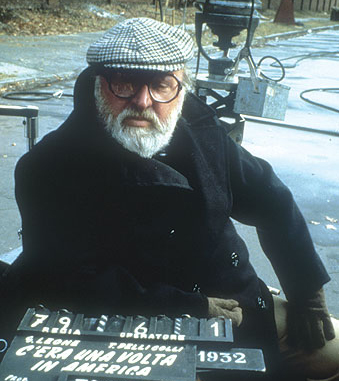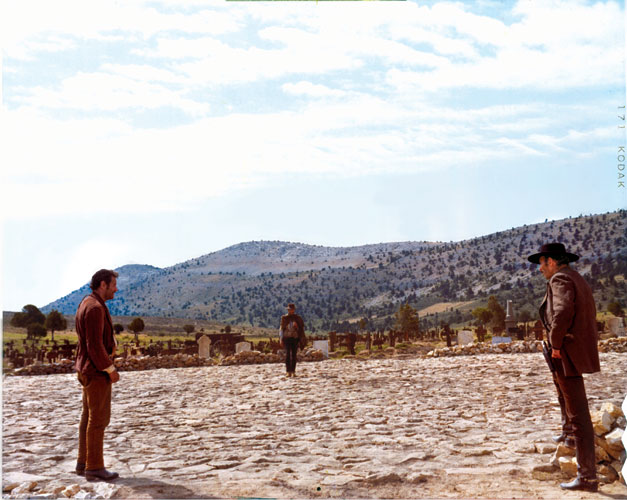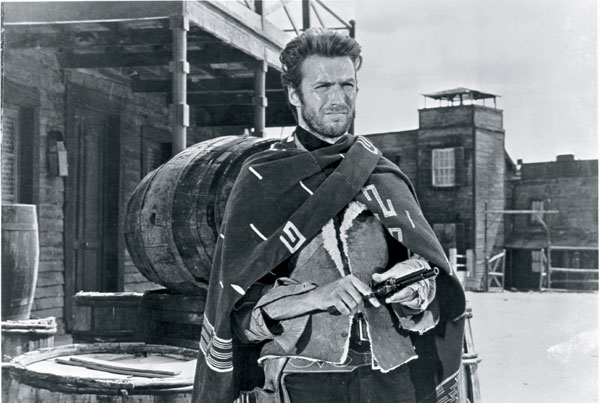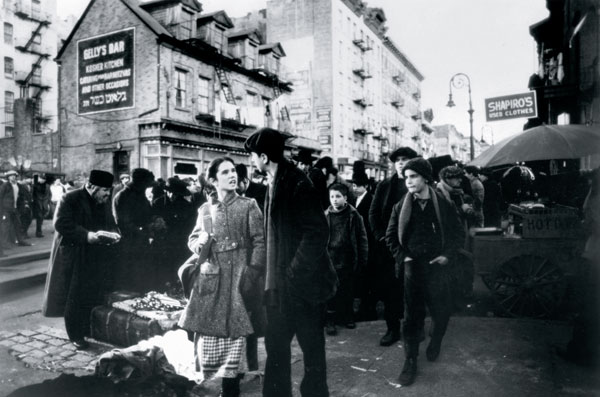BY GARY GIDDINS
 Sergio Leone (1985) (Credit: The Ladd Company/Photofest)
Sergio Leone (1985) (Credit: The Ladd Company/Photofest)
Sergio Leone's career is a parable of genius and ambition. To the industry born (his father directed and acted in dozens of silent films, many of them starring his mother), he began working at age 17, in 1946, as an unpaid assistant to Vittorio De Sica on The Bicycle Thief. During a long apprenticeship, Leone served as assistant director on various Italian and American epics. His reward for taking the reins from an ailing director and completing, without credit, a sword-and-sandals picture was the chance to direct his own film in the same genre, The Colossus of Rhodes (1961). Three years later, he made a bargain-basement Western that became an international blockbuster, A Fistful of Dollars.
Leone had realized every filmmaker's dream. Working with unknown actors and a $200,000 budget, he electrified a generation with the force of his visual style, remaking a fading genre into an expression of 1960s irreverence and disillusionment. Continuing in the Western idiom, he nursed a desire to become David Lean and demanded ever-larger budgets and longer running times. Yet despite the immense profits he generated, he was thwarted by censorship and cuts, especially by American distributors. His last film, the four-hour gangland saga, Once Upon a Time in America (1984), was slashed by 90 minutes, rendering it incomprehensible. When he died from heart failure at age 60 in 1989, he had directed only seven films. Not until recent years have the English-language versions been restored to their intended length.
 The Good, the Bad, and the Ugly (1967) (Metro-Goldwyn-Mayer Home Entertainment)
The Good, the Bad, and the Ugly (1967) (Metro-Goldwyn-Mayer Home Entertainment)
Seven films. Not a large legacy, but one that saved the Italian film industry when Hercules and friends wore out their welcome, and put an indelible mark on movies everywhere, not least on the American Western as practiced by Sam Peckinpah, Don Siegel, Robert Altman, and Clint Eastwood. Now his oeuvre is finally available in what appears to be authoritative DVD transfers. MGM's The Sergio Leone Anthology collects four of his five Westerns, accompanied by commentary tracks and companion discs with supplementary materials. In addition to A Fistful of Dollars and the much superior follow-up For a Few Dollars More (1965), it includes the 2003 restoration of The Good, the Bad and the Ugly (1967), now weighing in at three hours, and the 2006 restoration of Duck, You Sucker (1971), which is 37 minutes longer than the version originally seen in American theaters. In addition, Warner Bros. has brought out a spruced-up print of The Colossus of Rhodes in its "Cult Camp Classic" series. Paramount had previously released definitive editions of Once Upon a Time in the West (1968) and Once Upon a Time in America.
The qualities that made Leone's pictures jump off the screen in the 1960s continue to dazzle: startling visuals that play foreground against background with extreme close-ups against sweeping vistas; excruciatingly slow rituals that precede rapid bursts of violence; and comical immorality that marries the good, bad, and ugly (a Leone construct that quickly became a cliché). And, of course, there was the ingenious Ennio Morricone music, so relentlessly mocking or sentimental that it's difficult to tell when he's being sincere or ironic. One of the happy oddities of Leone's career is that A Fistful of Dollars did not play the United States until 1967, three years after it blanketed Europe. The delay allowed the film to open when antiwar fever was rising to a peak and youth culture was assuming a dominance that Hollywood had yet to acknowledge.
Leone's quiet man in a serape, jeans, and battered hat, eyes squinting with disbelief at the madness all around him, mouth locked on a homemade cigarillo, was the ideal fantasy figure for a generation—a soulful killer who defies authority, an anti-John Wayne (who, that very year, was directing The Green Berets). Small wonder that Clint Eastwood bounded into stardom. He created the first merciless killer as a witting Christ figure, resurrected from the dead to rain payback on the demented idiots in charge of everything—a theme Eastwood amplified in most of the Westerns he later directed.
The Western was a European tradition long before Leone. In Germany, the pathfinders and Indians of Fennimore Cooper had been adapted and idealized in novels by Karl May two decades before the fiction of Zane Grey. At least two dozen Italian Westerns rolled out of Cinecittà before Fistful, but they had been mostly cheapjack imitations of the Hollywood tradition. The first thing one notices in Leone's Westerns—actually, the fourth thing, after the striking visuals, relentless violence, and uncanny music—is the absence of almost every stock figure and convention of the genre. There are no or very few instances of Indians, cattle and cowboys, infallible heroes who kill out of necessity, farmers, ranchers, able law enforcers, mountains (except way off in the distance), children, and schoolmarms or other women who aren't whores.
 A Fistful of Dollars (1964) (Metro-Goldwyn-Mayer Home Entertainment)
A Fistful of Dollars (1964) (Metro-Goldwyn-Mayer Home Entertainment)
Leone's West is a flat, endless terrain, marauded by greed-addled gunmen and the hero who kills them and makes off with the loot. Death is both a sport and a pastime—in The Good, the Bad and the Ugly, Eastwood's "Good" and Eli Wallach's "Ugly" are partners in a lynching scam. Good turns Ugly in for reward money, then shoots the rope before it breaks his neck. As for moral distinctions, consider the film's 30-minute prelude in which they and Lee Van Cleef's "Evil" are introduced in sequential vignettes that involve each man killing three other men. Only Evil, however, kills children. In For a Few Dollars More, the marijuana-addled Indio (Gian Maria Volontè) murders a mother and infant child just to anger his real target. Frank, the hired assassin brilliantly played by Henry Fonda in Once Upon a Time in the West (giving a new and indelible meaning to cold blue eyes), smiles reassuringly at a child before shooting him. In all these films, shootouts are staged like bullfights in huge, spherical arenas as the opponents circle each other, the widescreen camera fixated on their panther movements and vigilant eyes. No woman ever claims the winner.
Leone's misogyny is unavoidable and constant: in Once Upon a Time in the West, the future of America is in the maternal hands of the water-bearing former whore played by Claudia Cardinale. In his cosmology, she represents the pinnacle of womanhood. After Tuesday Weld is humiliatingly raped in a bank in Once Upon a Time in America, she apparently has no choice but to become a whore and a moll. In Duck, You Sucker, a passenger in a Pullman stagecoach with the interior of a three-star hotel suffers a protracted rape for insulting Rod Steiger's peon bandit, an assault made especially cruel by Leone's feckless attempt to inject humor. Yet there is a strong kernel of guilt in his movies, sometimes involving women, and it comes out in his flashbacks.
The flashback is one of cinema's great contributions to the other arts, replacing memoir-narrative with time-bending recollections that flash backwards and forwards. Without film, it is difficult to imagine its use in fiction, like Faulkner's The Sound and the Fury, or theater, like Miller's Death of a Salesman. For Leone, the flashback has tremendous Freudian weight—animating action and explaining motive. In For a Few Dollars More, the villain is driven mad by the recollection of a woman shooting herself and not him while he raped her; in Once Upon a Time in the West, the hero has consecrated his life to avenge the killing of his family by Frank; and in Duck, You Sucker, a professional anarchist relives his execution of the traitor with whom he had shared a ménage à trois. The ultimate flashback movie is Once Upon a Time in America, in which the entire film is a chain of opium-stirred memories and fantasies, a superb metaphor for the wasted life suffocated by the weight of the past.
 Once Upon a Time in America (1984) (Credit: Warner Bros./Photofest)
Once Upon a Time in America (1984) (Credit: Warner Bros./Photofest)
Although all of Leone's films hold interest, not all are successful. The Colossus of Rhodes is pretty much what you expect, but rewards a visit for the Western-style horse chases; the femme fatale, whose curtain line is, "Funny, I wanted so much but I die without getting anything"; and the hollow-body Colossus, with a head that contains Medieval catapults that pour molten lead on enemies, as in The Hunchback of Notre Dame. The scene in which Rory Calhoun climbs out of the statue's ear and fences with soldiers is whimsical Leone. Duck, You Sucker, his most serious attempt at a political statement, founders on uneasy 1970s comedy overlaid on the Mexican Revolution, and Rod Steiger's accent wanders all over Latin America, prefiguring Al Pacino's Cuba-speak in Scarface. The film can't make up its mind about the revolution, which destroys Steiger's children but turns him into a human being.
Leone turned down The Godfather to pursue his dream project, a story not of Italian mobsters, but of a Jewish gang that worked its way up from petty crimes in Prohibition New York to labor and politics. Inspired by the memoir/novel, The Hoods, by Harry Grey, Leone focused on the story of friends who betray each other and created his most painful and ecstatic film. Once Upon a Time in America lacks the upbeat adrenaline of The Good, the Bad and the Ugly and the eulogistic majesty of Once Upon a Time in the West, but it is his most deeply felt work. Once Upon a Time in America is at once a tapestry of ingenious set-pieces that capture the vanished immigrant life of the Lower East Side and an elegy for lost time, set to an affecting Morricone score.
Leone made his regard for Morricone clear in the credits of For a Few Dollars More, holding his name for a full 12 seconds, twice the length of the director's credit. In subsequent films, he encouraged Morricone to write music in advance to establish mood. Much of Once Upon a Time in America unreels to Morricone's clarinet arrangement of the 1924 song "Amapola." The film isn't always logical, but logic isn't Leone's strong suit. In The Good, the Bad, a Union commander, beset by spies, detains Eastwood and Wallach, and when Wallach says they want to enlist, the officer immediately spills his tactical secrets. Leone will not allow coherence to block the route to action. In Once Upon a Time in America, logic is mooted in part by opium, but reveries are allowed their full emotional toll. For all the violence and treachery, it's a masterpiece of sentimental affirmation.